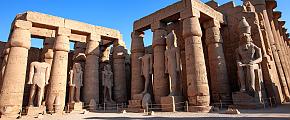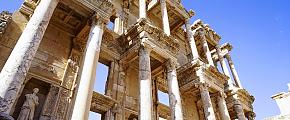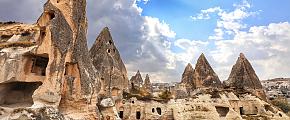Morocco Travel Guide
Country Overview
Morocco feels like a country made for travelers to visit: a fantasy land full of lyrical landscapes and fabulous imperial cities, where African and Arab worlds merge, and different cultures and religions coexist in harmony. From the mountains of the High Atlas to idyllic shores bathed by the Mediterranean, Morocco caters for all tastes. Explore the Medina of Fez and wonder at the beauty of its palaces and mosques, shop till you drop in Marrakesh souks and camp overnight in the dunes of Sahara Desert. Time seems not to pass in this authentic paradise of North Africa.
Country at a Glance
- Capital: Rabat
- Population: 37 million
- Language: Arabic, Berber, French
- Currency: Moroccan dirham (MAD)
- Time zone: UTC +1
- Electricity: 220 V / 50 Hz. Sockets: Types C and E
- Dialing code: +212
Best Time to Visit Morocco
Spring (March to May) and early autumn (September-October) are widely considered the best time to visit Morocco, when the climate is pleasant throughout the country; neither too hot not too cold, and there are fewer tourists than during the summer or winter vacation periods.
Heat is severe during the summer months, particularly in the Sahara Desert. Coastal destinations are good choices at this time of the year -they can be visited year-round- and cities like Casablanca or Essaouira can be pleasantly warm, but the southern part of the country will be too hot for daytime exploration.
Winters are generally mild, but temperatures fall dramatically at night and it might even snow in Atlas Mountains. During this season, it will be wet in the north and dry -but cold- in the south.
During the month-long Islamic Festival of Ramadan, Muslims fast from dawn until the sun has set. It might affect transport and the opening hours of some stores/restaurants but it should not be a significant drawback when traveling to Morocco.
Top Places to Visit
Beautiful imperial cities and ancient towns, coastal resorts full of paradise beaches, dramatic landscapes of mountain ranges, charming maze-like souks, sweeping deserts... Morocco has everything you are looking for and everything you dream of. These are some cities that you definitely should visit.
Marrakesh
This magical Red City comprises the ancient walled Medina, full of palaces, mansions, gardens and mosques. You will admire breathtaking examples of Islamic architecture such as the Ben Youssef Madrasa and the impressive Koutoubia minaret and experience the local way of life in Jemaa el-Fnaa, one of the largest and busiest squares in the world.
Rabat
Not established as one of the main tourist hubs, the capital of the country has managed to maintain its cultural identity. In addition to its famous medina, the Kasbah of the Udayas is an impressive historic site, and the Hassan Tower and the 20th-century Mausoleum of Mohammed V are among the most visited attractions.
Casablanca
The largest city in the Maghreb and the commercial and economical center of the country, Casablanca is the main gateway to Morocco (through Mohammed V Int. Airport). The Hassan II Mosque -second largest in the world-, with its 200-meter minaret, dominates this bustling city, whose corniche is home to many beach clubs, restaurants and hotels.
 Hassan mosque
Hassan mosque
Fez
Home to the oldest university in the world, the imperial city Fez takes you back to Medieval times. The extraordinary Medina of Fez el Bali -the city's oldest neighborhood- is home to historic monuments and mosques, beautiful alleyways and squares, and countless tanneries.
Chefchaouen
Nestling on the foothills of the Rif Mountains, Chefchaouen was originally built as a fortress in the 15th century. Delight yourself wandering around the medina, famous for its gorgeous blue-tinted houses and buildings. This peaceful town is an important touristic attraction and a main starting point for mountain walks.
Tangier
Africa and Europe meet each other in one of the most ancient cities in North Africa. Located on the Strait of Gibraltar at the entrance of the Mediterranean Sea, its unique blend of cultures and influences is reflected in its medina, kasbah and souks, and has attracted artists and socialites for decades.
Meknes
Home of the Moroccan sultanate around 300 years ago, Meknes is the smallest and most relaxed of the four imperial cities of the country. It is known for its Moorish architecture and medieval walls, and the nearby Roman ruins of Volubilis which are the most well-preserved archeological site in Morocco.
Top Things to Do
You can never get enough of Morocco. As the gate to Africa, the country is a delightful mixing of different cultures with countless historical and natural sceneries. Morocco is made for explorers: dunes, souks, kasbahs, mountains, hammams... an eclectic destination with something for everyone.
Camel Trekking in the Sahara Desert
The village of Merzouga is the place to go for those who want to feel like real adventurers. You can surf the dunes of Erg Chebbi, and riding a camel in the Sahara Desert, as well as camping overnight in a Berber tent, will be unforgettable experiences.
 Sahara Desert
Sahara Desert
Explore the Ksar of Ait Benhaddou
Near the city of Ouarzazate, you may recognize this impressive ksar as the shooting location of many famous movies such as Lawrence of Arabia, The Jewel of the Nile or Gladiator. Admire the beauty of its towers and the buildings and lanes inside, full of shops and tourists. Although there is no electricity inside, it is possible to overnight.
Take a Cooking Class
If this is not in your plans when you land in Morocco, you will definitely want to include it after your first lunch. An amalgamation of many different influences, Moroccan cuisine is famous for its fragrant spices. Learn from a local chef how to cook traditional Moroccan food and impress your friends back home!
Visit a Tannery in Fez
Famous all over the world for its leather products, Fez boasts tanneries that have been in operation for centuries, Chouara -located inside the medina- being the most popular. Put up with the strong odor and you will enjoy spectacular sights of hundreds of vessels filled with colorful dyes and skins drying in the rooftops.
Trekking in the High Atlas
The highest mountain range in North Africa stretches diagonally from the west coast of Morocco to Tunisia. Its stunning valleys, with landscapes that vary from season to season, make it Morocco's premier trekking destination, much sought-after by hikers, mountaineers, bikers or rock climbers. To make things easier, mules are available for hire.
Explore the Roman Ruins of Volubilis
On a high plateau only 30 km north of Meknes -can be easily visited as a day trip- lies the ruined Roman city of Volubilis, which is the best-preserved archaeological site of the country, with impressive mosaics still interred where they were unearthed.
Jemaa El-Fnaa
This bustling square located at the heart of the medina is the nerve center of Marrakesh. Depending on the time you arrive, you may find lots of juice stalls and street vendors; or dancers, jugglers, snake-charmers and story-tellers; or a big open-air dining area with restaurants firing up their grills.
Shopping
One of Morocco's main attractions are its souks; street markets that can be found in almost every city -usually within the old towns or medinas-, although the most famous are in Marrakesh and Fez. Your visit to Morocco would not be complete without at least one visit to these maze-like shopping paradises filled with colors, sounds and smells, where vendors fiercely advertise hordes of treasures. Bring your best haggling skills and be prepared to bargain for the lowest prices, and remember to plan some extra space in your luggage.
Carpets
Morocco has the most beautiful carpets you will ever come across. Distinctive intricate designs, embroideries and weaving styles from more than forty different Berber tribal groups will give you plenty of options to choose from.
 Morocco carpets
Morocco carpets
Djellaba
Upgrade your wardrobe with a touch of color with this traditional Moroccan garment. A long, loose-fitted robe for both men and women, in different shapes and colors. Get it in a souk or have it custom-made by a local tailor.
Leatherware
Manufacturing of leather goods is a timeless tradition in Morocco. Famous all over the world, Moroccan leather comes in a myriad of forms, from popular babouches -slippers- to pouffes that you can easily take home without the stuffing.
Argan Oil
Extracted from roasted seeds from the Argania plant, these oils are not found anywhere else in the world. Harvesting and cultivating Argan oil is an old tradition in Marrakesh. It is a great condiment for food, and also used for cosmetic purposes.
What to Eat
Couscous is arguably the most famous dish, but Moroccan cuisine is as diverse as delicious. Known for the extensive use of aromatic spices, influences from Arab, Berber and Mediterranean cuisines have all played an important part in its development. You will find that food in Morocco is usually fresh and locally grown rather than shipped in, and it varies seasonally.
Meals usually start with harira -a traditional heavy soup-, bissara -thick pea soup topped with olive oil- or with a salad, and continue with a plateful of kebabs. Couscous is a staple food, usually served with various vegetables and meat (mutton or chicken) cooked with spices on top. Tagine is another signature dish in Morocco, although the word refers to a pot rather than to the food cooked in it. It is a ceramic conical plate covered with a lid. The meat is arranged in the middle, with the vegetables piled around it, and left to cook slowly after. Most classic tagines combine chicken with olives and lemons, and lamb or beef with prunes and almonds. Pastilla is a chicken or pigeon pie that combines sweet and salty flavors, and merguez, another local classic, are spicy homemade lamb sausages.
Mint tea can be considered as the national drink; green tea is flavored with springs of mint and sweetened with sugar. Coffee is a popular beverage throughout the country as well. Tap water is usually safe to drink, although you will see that most tourists prefer bottled water. As Morocco is an Islamic nation, you will not see many alcoholic drinks other than in bars (usually all-male) or touristic spots.
Getting Around
Royal Air Maroc runs nonstop flights to Casablanca from New York and Montreal, although changing planes at a European hub (mainly Spain or France) is also a popular way to get to the country. Many flights (and ferries) connect Morocco with Europe and the Middle East.
There are plenty of good transport options within Morocco, so getting around is relatively easy. Train is the best choice for traveling between the main cities, the coast and Marrakesh. The two main lines connect Marrakesh with Tangier (via Casablanca and Rabat), and Marrakesh with the northeastern city of Oujda (passing Meknes and Fez). Both lines join at Sidi Kacem. From 2018, a high-speed line links Tangier, Rabat and Casablanca, reaching 320 km/h. Buses are cheaper and generally safe, but significantly slower.
There are two types of taxis in Morocco: petit taxi and grand taxi. Petit ("small") taxis are only for local city traffic, while grand ("big") taxis are permitted to travel outside the city limits. Grand taxis are shared with other travelers, so you only pay for your seat. Since the driving standards, condition and safety in Morocco do not match those in the West, you might want to consider hiring your own private vehicle and driver.
Dressing
Morocco dress code is not strict, but it is predominantly a Muslim country, so it is convenient to dress conservatively. Be considerate of local customs; cover your shoulders if you don't want to receive unwanted attention. Looser tops work well not only for modesty but also to protect against the heat, always choose breathable fabrics when packing your luggage. Shorts may not be appropriate in rural areas which tend to be more conservative than big cities. It is not necessary for non-Muslim women to top conceal their hair. Moroccans tend to live prudently so, in a similar way, avoid displaying flashy jewelry, luxury handbags or even high-end electronics. Most tours involve a lot of walking, so make sure you bring comfortable shoes. Sandals will help you to keep your feet cool. Evenings can get cold during the winter, so pack at least one sweater if you are visiting the country between November and March.
Accommodation
Hotels and resorts in the main cities can get very busy during the summer months, as well as over the Easter and Christmas/New Year periods, so booking in advance will be a good idea. The range of accommodation is as rich and diverse as the country itself. There are hotels of every class and style, and prices are usually cheaper than in most western countries. Indulge yourself in converted Kasbahs in the mountains, beach resorts along the Atlantic coast or beautiful riads in the city medinas.
In Morocco, hotels are distinguished between those classified by the Moroccan tourist board and those that are not. In the government rating system, hotels are awarded stars for their facilities (pool, restaurant, etc.) more than for their service, so it is not advisable to rely on the star rating. Unclassified hotels are usually cheap places with very basic facilities. Staying in a riad (also known as maison d'hôtel) will be one of the highlights of your trip to Morocco. These classic townhouse-style housings usually have two or three floors around a patio garden with a fountain, with rooms traditionally decorated with wooden door and window frames and mosaic artwork.
One night at the Sahara Desert is another essential experience: dine out around a campfire under the stars and overnight in a tent. Desert camps range from basic to luxurious.
Quick Question
What Our Clients Say
"Great Service and Value", "Exceed All Expectations", "Highly Recommend".SUBSCRIBE TO WIN A FREE TOUR
Subscribe to our newsletter for a chance to win a free 7-day tour to Vietnam! And more insider travel news, exclusive offers, and inspiration will be sent straight to your inbox. Check our previous newsletters and get some sparks.





